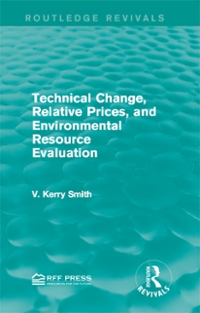Question
Consider an oil industry facing a linear demand curve for aggregate output qt. Let the demand for oil be represented by the following inverse demand
Consider an oil industry facing a linear demand curve for aggregate output qt. Let the demand for oil be represented by the following inverse demand curve: pt=abqt. An important characteristic of the linear demand curve is that the implied maximum or "choke-off" price occurs at the intercept where pt=a when qt= 0. In scheduling their production, firms are assumed to know about this backstop/substitute.
Let industry profits in any given period t be denoted as t=pt*qtc*qt, and assume that the industry chooses an extraction path {q0,...,qT} to maximize the net present value of industry profits over T years, subject to the stock constraint S0=qt. Let = 1/(1 +r) indicate the industry's discount factor.
A) Suppose that the oil industry is perfectly competitive so that all firms are the same and small enough that they take the price of oil p as given.
(i) Write down the Lagrangian function that characterizes the industry's maximization problem. Write down and interpret the first-order conditions.
(ii) What must the price be equal to in the last period? Explain intuitively why this is the case.
(iii) Using the flow, stock and terminal conditions, derive an implicit equation (or expression) for the date of exhaustion T.
Step by Step Solution
There are 3 Steps involved in it
Step: 1

Get Instant Access to Expert-Tailored Solutions
See step-by-step solutions with expert insights and AI powered tools for academic success
Step: 2

Step: 3

Ace Your Homework with AI
Get the answers you need in no time with our AI-driven, step-by-step assistance
Get Started


